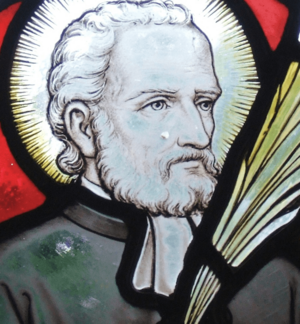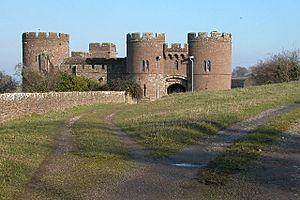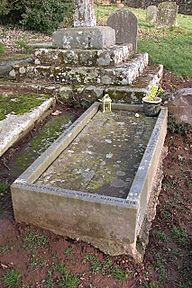John Kemble (martyr) facts for kids
Quick facts for kids SaintJohn Kemble |
|
|---|---|
 |
|
| Priest and Martyr | |
| Born | c. 1599 St Weonards, Herefordshire, England |
| Died | 22 August 1679 (aged 79 - 80) Widemarsh Common, Hereford, Herefordshire, England |
| Venerated in | Roman Catholic Church |
| Beatified | 15 December 1929 by Pope Pius XI |
| Canonized | 25 October 1970 by Pope Paul VI |
| Major shrine | His grave in the churchyard of St Mary the Virgin at Welsh Newton |
| Feast | 22 August, 25 October |
| Attributes | martyr's palm |
John Kemble (born around 1599, died August 22, 1679) was an English Catholic priest. He is known as a martyr, someone who died for their beliefs. John Kemble is one of the Forty Martyrs of England and Wales, a group of people honored by the Catholic Church.
Contents
Becoming a Priest: John Kemble's Early Life
John Kemble was born in 1599 at Rhydicar Farm in St Weonards, Herefordshire, England. His family, the Kembles, were well-known Catholics in the area. They continued to practice their faith even when it was against the law. Four other priests came from his family, including his cousin, David Lewis, who also became a martyr.
John Kemble studied to become a priest at Douai College in France. He was made a priest on February 23, 1625. Soon after, on June 4, 1625, he returned to England. He worked as a priest helping Catholic communities in Monmouthshire and Herefordshire.
Serving His Community: John Kemble's Work
In John Kemble's time, there were strict laws against Catholics in England. However, how much they were bothered often depended on local leaders. In areas like Hereford and Monmouth, a powerful Catholic family, the Earls of Worcester, protected Catholics. This meant that the old Catholic religion could be practiced more openly there.
John Kemble worked as a traveling priest for over 50 years. He cared for his Catholic community, even gaining respect from Protestants. Not much is known about his daily work during these 53 years. Priests still had to be careful and quiet about their ministry. John Kemble lived at Pembridge Castle, which belonged to his nephew, Captain Richard Kemble. For a long time, he seemed safe from being arrested.
The Popish Plot: A Time of Danger
The peaceful situation for Catholics changed suddenly in 1678 because of something called the Popish Plot. This was a made-up story by a man named Titus Oates. He falsely claimed that Catholics were planning to kill the Protestant King Charles II. Oates said they wanted to replace him with his Catholic brother, who later became King James II.
Even though Oates's story was proven to be false, it caused a lot of fear and anger. Some politicians used this fake "plot" to accuse English Catholics, especially priests. Many Catholics, including John Kemble, were caught up in this dangerous time. Another priest, David Lewis, was arrested at St. Michael's Church in Llantarnam.
Arrest and Execution: John Kemble's Final Days
Father Kemble was staying at Pembridge Castle, near Welsh Newton, when he was arrested on December 7, 1678. He had been warned that he was about to be arrested but chose not to run away. He said he was old and ready to suffer for his faith. Captain John Scudamore arrested him, even though Scudamore's own wife and children were part of Kemble's community.
Kemble was held in Hereford Gaol until the spring of 1679. In April 1679, John Kemble, who was about 80 years old, was ordered to go to London. Officials wanted to question him about the plot. Because he was so old and had trouble riding, he was tied to his horse like a package for the journey. He was found to have no connection to the fake plot. However, he was still found guilty of treason just for being a Catholic priest. He was sentenced to be hanged, drawn and quartered.
He was sent back to Hereford for his sentence to be carried out. He was allowed to walk most of the way back.
Before his execution on August 22, 1679, Kemble wanted to say his prayers and finish his drink. The people gathered with him, including the executioner, shared a final smoke and a drink. In Herefordshire, the sayings "Kemble pipe" and "Kemble cup" refer to a last pipe or drink before leaving. Before he died, Kemble spoke to the crowd. He told them that he was not accused of being part of any plot. He said he was dying only because he was a Catholic priest. He reminded them that the Catholic faith was the first religion in England.
He even comforted his upset executioner, whispering, "Honest Anthony, my friend Anthony, do not be afraid; do your job. I forgive you with all my heart. You will do me a greater kindness than discourtesy."
John Kemble was allowed to die on the gallows before the rest of the harsh sentence was carried out. This meant he did not suffer as much as many other Catholic martyrs. He died on August 22, 1679, at Widemarsh Common in Hereford. Many people in the area, both Protestants and Catholics, were sad about his death. They praised him as a "great gentleman."
One of Kemble's hands is still kept at St Francis Xavier Church in Hereford city center. His body is buried in the churchyard of St Mary the Virgin at Welsh Newton. Catholics from the area make a special trip to his grave every year.
Sainthood: Honoring John Kemble
Soon after his death, people believed that miracles happened because of the holy priest. Captain Scudamore's daughter was cured of throat cancer. Scudamore's wife also got her hearing back while praying at Kemble's grave.
John Kemble was declared "blessed" (a step towards sainthood) in 1929 by Pope Pius XI. He was then made a saint on October 25, 1970, by Pope Paul VI. He is honored as one of the Forty Martyrs of England and Wales.
Important Dates
- Made a saint on October 25, 1970, by Pope Paul VI.
- October 25 is the Feast Day of the Forty Martyrs of England and Wales.
See also
- Welsh Newton - Learn more about Pembridge Castle and Father Kemble's connections to the area.
Sources
- Encyclopædia Britannica, 15th Edition
- Edmund Campion, by Evelyn Waugh, Longmans, Green and Co., 1935



